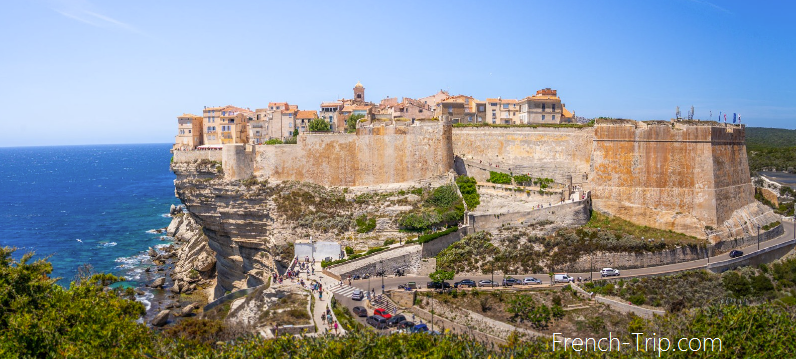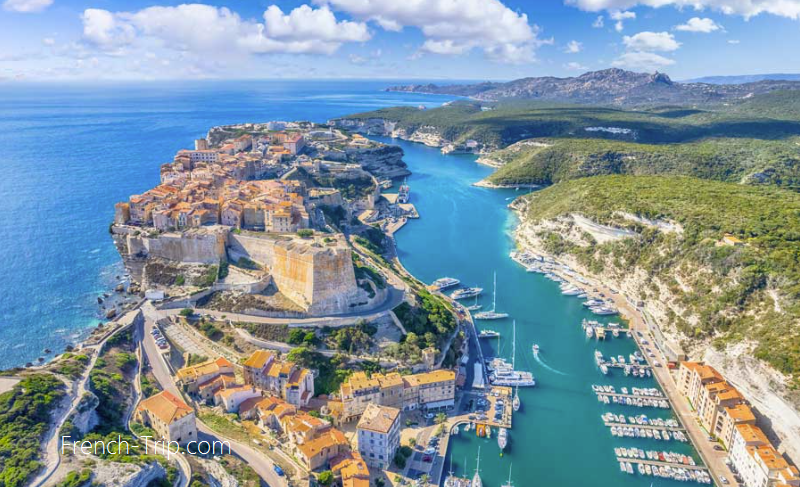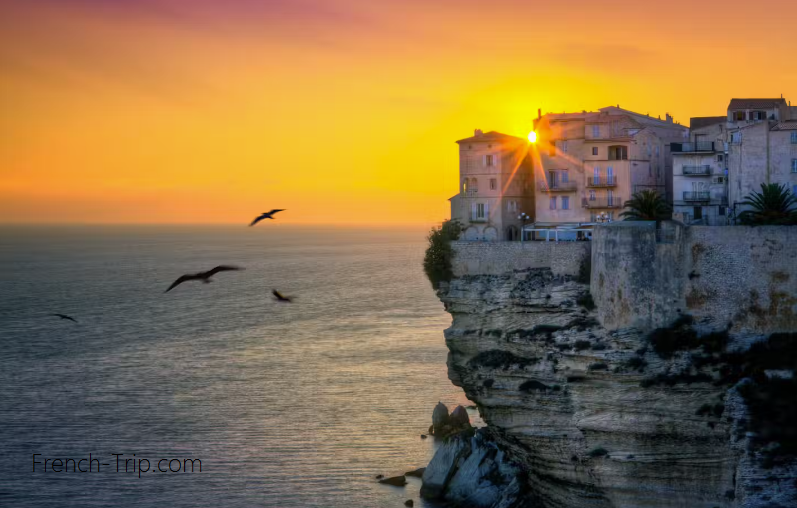History of Bonifacio

History of Bonifacio starts in ancient time. About forty years ago, archaeologists discovered the skeleton of a 35-year-old woman who lived nearly 7,000 years before our era in a cave not far from the port. Named “the lady of Bonifacio,” this skeleton testifies to the presence of settlements on the peninsula since prehistoric times.
In ancient times, different peoples occupied the territory and its region over various periods: Phoenicians, Carthaginians, Phocaeans, Romans. The presence of the latter is attested by the remains of the Roman village of Sperone-Piantarella, by that of a jar burial on Sant’Amanza, by the exploitation of the quarries of the island of Cavallo and San Baïnzo, by the numerous bronze and silver medals found at Piantarella with the effigies of Antoninus Pius, Septimius Severus, Marcus Aurelius and Plautilla-Augusta or by the place called “Campu Rumanilu” (Roman camp).
History of Bonifacio
The Gibraltar of Corsica
In the Middle Ages, Bonifacio was an almost impregnable base, easy to defend both on land and at sea. This “Corsican Gibraltar” aroused much covetousness, particularly that of Pisa and Genoa, who fought over it for a long time. But it was Pisa that occupied it first. Genoa had to wait until the end of the 12th century to take control of the place, partly because the site, due to its strategic position, suited it, but mainly because of the attacks perpetrated by Pisan pirates who, from Bonifacio, scoured the strait and attacked their ships.
The Genoese therefore chased the Pisans out of Bonifacio and established a colony of 1,200 members there, all Ligurian volunteers representing various trades. Little by little they developed the city towards the east where there were already buildings including the church of Santa Maria Maggiore and also small streets, since the “platea longa” (the long street) is mentioned in 1238. The Genoese castle was gradually surrounded by ramparts of more than 2 km in circumference.
The Republic of Genoa then granted the new inhabitants many privileges: tax exemption, bonus for large families, it endowed the city with statutes that gave Bonifacio a certain autonomy. However in the field of defense it depended on the “Serenissima Republica”
A little later (14th century) it had the right to mint money (Genoese money over-struck with the letter B) but also Bonifacian money made on site.

The memorable sieges, the King of Aragon….
In the spring of 1420, Alphonse V, King of Aragon, then master of Sardinia, came to lay siege to Bonifacio. The capture of this stronghold could make him possessor of all of Corsica, although Calvi had resisted. He was far from suspecting the heroism of the Bonifacians. The population lent a hand to the garrison. This ended in failure for the King of Aragon.
133 years later, Dragut
In 1533, Paul de Thermes had instructed the former privateer Dragut, admiral of the Turkish fleet, to lay siege to Bonifacio and sent a few companies of Corsicans and Frenchmen there. The landing took place at the Gulf of Santa Manza. The resistance of the Bonifacians was once again most commendable, but this time the enemy was the strongest. It was necessary to capitulate. Add to this the betrayal of the envoy from Genoa, Cattaciolo, who had sided with the French.
The governor of Bonifacio agreed to surrender the city on condition that the inhabitants and the garrison were spared. Entrusted to the French alone, they carried out work to modernise the fortifications. The walls were reinforced with earth ramparts, embankments built on the curtain walls, and towers (the main ones) transformed into bastions. “It is this fortification begun by the French and completed by the Genoese that can still be admired today“. In 1559 (Treaty of Cateau Cambresis), the French left. Bonifacio was returned to the Genoese.

The plague of 1528
Before this last siege, the city of Bonifacio suffered from a devastating plague epidemic. The Bonifacians were just beginning to recover from the memorable siege of 1420 and life was going on peacefully. Alas, a terrible scourge was about to ravage the population: the plague. This disease claimed more victims than the escopettes and bombards of the King of Aragon. In 1768, like the rest of the island, Bonifacio became French, thereby losing many of the privileges granted by Genoa. It fiercely defended its former position with the guardianship in vain. The Bonifacians were under the protection of the King of France, those who refused their new situation were invited to leave… to Genoa.
English Bonifacio
In 1793 the history of the city was marked by the attack of the French revolutionary troops against the Maddalena archipelago in which Bonaparte was to take part, after an attack plan established by the extraordinary Bonifacio deputy Antoine Constantini. The attack plan provided for a landing on the islands of Maddalena and Caprera, then an advance on the North of Sardinia and the capture of Sassari.
Another expedition was to take place simultaneously towards the South of Sardinia with the objective of capturing Cagliari. The resistance of the Sardinians was astonishing. The first opportunity for glory offered to Bonaparte’s courage was annihilated. It was the shameful and humiliating retreat.
This battle of La Maddalena became for most historians “the unfortunate expedition of La Maddalena”

Slow decline, painful renewal
If in the 19th century, Bonifacio experienced a certain renewal in the agricultural field, the situation was to change when phylloxera arrived and destroyed all hopes. The cultivation of olive trees allowed the region to produce 5000 hectoliters of oil per year.
There was also a tuna fishery in the Gulf of Ventilegne, pasta factories, a cork stopper factory which were among the four most important in France, coral fishing which was flourishing during the entire first half of the 19th century.
Suddenly everything was to change, all sources of work and wealth were dried up. The exodus of the population was inevitable, especially towards Marseille. The final blow was the war of 14-18 and its consequences. As an important garrison town, Bonifacio held its own.
Today, thanks to tourism, Bonifacio is trying to “recover its health”. The historic town attracts hundreds of thousands of tourists per year, making it the most visited centre in Corsica. It is also the number one for pleasure boat traffic and second after Ajaccio for cruise ships. This still important fishing port (seat of the prud’homie and the Bureau of Maritime Affairs) benefits from daily traffic with nearby Sardinia (14 km away). With 300,000 passengers per year, Bonifacio is the 3rd commercial port on the island after Bastia and Ajaccio.

→ Back to Bonifacio travel guide
Archives
Calendar
| M | T | W | T | F | S | S |
|---|---|---|---|---|---|---|
| 1 | 2 | 3 | 4 | 5 | 6 | 7 |
| 8 | 9 | 10 | 11 | 12 | 13 | 14 |
| 15 | 16 | 17 | 18 | 19 | 20 | 21 |
| 22 | 23 | 24 | 25 | 26 | 27 | 28 |
| 29 | 30 | 31 | ||||